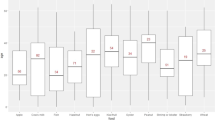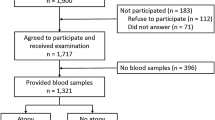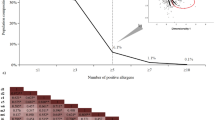Abstract
Objective:
To compare the prevalence of self-reported food allergy and IgE antibodies to food allergens in wheezing and non-wheezing Estonian and Swedish schoolchildren, in the light of the disparities in the standard of living, food consumption and prevalence of respiratory allergies that still exist between Estonia and the Scandinavian countries.
Design and setting:
As a part of the ISAAC Phase II study, children from a random sample of schools in Tallinn in Estonia and Linköping and Östersund in Sweden participated in skin prick tests to inhalant allergens and the parents replied to questionnaires. IgE antibodies against a panel of food allergens (egg white, milk, soy bean, fish, wheat and peanut) were taken from children with questionnaire-reported wheezing and a random sample of nonwheezing children.
Subjects:
Children aged 10–11 y.
Results:
The prevalence of self-reported food allergy was similar in Estonia and Sweden and about twice as high in wheezing children than in nonwheezing children. In Estonia, however, 3% of the children with perceived food allergy reported reactions from at least four different foods, as compared to 31% in Sweden. The prevalence of sensitisation to food allergens was similar in wheezing and nonwheezing children in Estonia (8%) while, in Swedish children, IgE antibodies to food allergens were more likely among wheezing children (Linköping 38 vs 11%, crude OR 5.1, 95% CI 2.2–11.6, and Östersund 24 vs 7%, crude OR 4.1, 95% CI 1.9–8.5).
Conclusion:
Our study suggests that IgE-mediated food reactions were less likely in Estonian schoolchildren. Moreover, the perception of food allergy and thereby the meaning of self-reported food allergy appears to be different in the two countries.
Sponsorship:
This study was supported by a grant from the Swedish Foundation for Health Care Sciences and Allergy Research.
This is a preview of subscription content, access via your institution
Access options
Subscribe to this journal
Receive 12 print issues and online access
$259.00 per year
only $21.58 per issue
Buy this article
- Purchase on Springer Link
- Instant access to full article PDF
Prices may be subject to local taxes which are calculated during checkout
Similar content being viewed by others
References
Annus T, Björkstén B, Mai XM, Nilsson L, Riikjärv MA, Sandin A & Bråbäck L (2001): Wheezing in relation to atopy and environmental factors in Estonian and Swedish schoolchildren. Clin. Exp. Allergy 31, 1846–1853.
Böttcher MF, Nordin EK, Sandin A, Midtvedt T & Björkstén B (2000): Microflora-associated characteristics in faeces from allergic and nonallergic infants. Clin. Exp. Allergy 30, 1590–1596.
Bråbäck L (1999): Do infections protect against atopic diseases? Acta Paediatr. 88, 705–708.
Brugman E, Meulmeester JF, Spee-van der Wekke A, Beuker RJ, Radder JJ & Verloove-Vanhorick SP (1998): Prevalence of self-reported food hypersensitivity among school children in The Netherlands. Eur. J. Clin. Nutr. 52, 577–581.
Gislason D, Björnsson E, Gislason T, Janson C, Sjöberg O, Elfman L & Boman G (1999): Sensitization to airborne and food allergens in Reykjavik (Iceland) and Uppsala (Sweden)—a comparative study. Allergy 54, 1160–1167.
ISAAC Steering Committee (1998): Phase II Modules of The International Study of Asthma and Allergies in Childhood (ISSAC). Münster: Institute of Epidemiology and Social Medicine, University of Münster.
Julge K, Vasar M & Björkstén B (1997): The development of atopic sensitization in Estonian infants. Acta Paediatr. 86, 1188–1194.
Julge K, Vasar M & Björkstén B (2001): Development of allergy and IgE antibodies during the first five years of life in Estonian children. Clin. Exp. Allergy 31, 1854–1861.
Kalliomäki M, Salminen S, Poussa T, Arvilommi H & Isolauri E (2003): Probiotics and prevention of atopic disease: 4-year follow-up of a randomised placebo-controlled trial. Lancet 361, 1869–1871.
Kristjansson I, Ardal B, Jonsson JS, Sigurdsson JA, Foldevi M & Björkstén B (1999): Adverse reactions to food and food allergy in young children in Iceland and Sweden. Scand. J. Prim. Health Care 17, 30–34.
Mattila L, Kilpeläinen M, Terho E, Koskenvuo M, Helenius H & Kalimo K (2003): Food hypersensitivity among Finnish university students: association with atopic diseases. Clin. Exp. Allergy 33, 600–606.
Sepp E, Julge K, Vasar M, Naaber P, Björkstén B & Mikelsaar M (1997): Intestinal microflora of Estonian and Swedish infants. Acta Paediatr. 86, 956–961.
Vieths S, Scheurer S & Ballmer-Weber B (2002): Current understanding of cross-reactivity of food allergens and pollen. Ann. N.Y. Acad. Sci. 964, 47–68.
Woods RK, Abramson M, Bailey M & Walters EH (2001): International prevalences of reported food allergies and intolerances. Comparisons arising from the European Community Respiratory Health Survey (ECRHS) 1991–1994. Eur. J. Clin. Nutr. 55, 298–304.
Woods RK, Stoney RM, Raven J, Walters EH, Abramson M & Thien FC (2002): Reported adverse food reactions overestimate true food allergy in the community. Eur. J. Clin. Nutr. 56, 31–36.
Acknowledgements
We wish to thank Ing-Marie Sandberg, Lena Lindell, Lena Spets, Kristina Fluur-Hedman and Karin Helgesson for performing the SPTs and the blood samples. This work was supported by a grant from the Swedish Foundation for Health Care Sciences and Allergy Research.
Author information
Authors and Affiliations
Corresponding author
Additional information
Guarantor: A Sandin.
Contributors: AS collected data, analysed data, wrote the manuscript and involved in the final approval of the manuscript. TA coinvestigator, collected data and involved in the final approval of the manuscript. BB involved in study design and in the final approval of the manuscript. LN coinvestigator, involved in the final approval of the manuscript. M-AR coinvestigator, involved in the final approval of the manuscript. M van H-H data analyses and involved in the final approval of the manuscript. LB coinvestigator, involved in study design, data analysis and in the final approval of the manuscript.
The work was carried out at the Division of Paediatrics, Linköping University, the Department of Paediatrics, Östersund Hospital, and Karolinska Institutet.
Rights and permissions
About this article
Cite this article
Sandin, A., Annus, T., Björkstén, B. et al. Prevalence of self-reported food allergy and IgE antibodies to food allergens in Swedish and Estonian schoolchildren. Eur J Clin Nutr 59, 399–403 (2005). https://doi.org/10.1038/sj.ejcn.1602087
Received:
Revised:
Accepted:
Published:
Issue Date:
DOI: https://doi.org/10.1038/sj.ejcn.1602087
Keywords
This article is cited by
-
Gut microbiota and atopic dermatitis in children: a scoping review
BMC Pediatrics (2022)
-
Late introduction of solids into infants’ diets may increase the risk of food allergy development
BMC Pediatrics (2020)
-
High incidence and remission of reported food hypersensitivity in Swedish children followed from 8 to 12 years of age – a population based cohort study
Clinical and Translational Allergy (2014)
-
Common Methodologies in the Evaluation of Food Allergy: Pitfalls and Prospects of Food Allergy Prevalence Studies
Clinical Reviews in Allergy & Immunology (2014)
-
A global survey of changing patterns of food allergy burden in children
World Allergy Organization Journal (2013)



